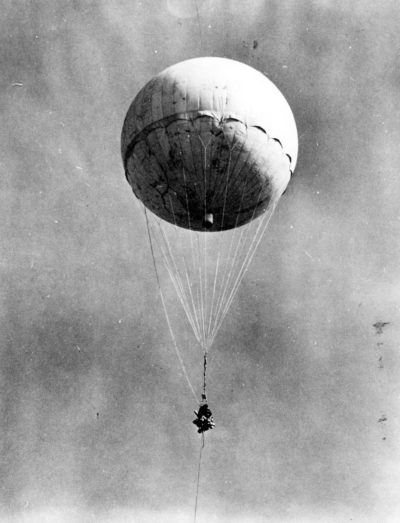By Michael W. Vogt
Moving with his family from Oskaloosa, to a 22-acre ranch west of Roseburg, Ore., in 1945, 12-year-old Robert E. Johnston was witness to a Japanese attack on the United States during World War II.

Japan launched more than 9,300 paper balloons carrying bombs over the Pacific Ocean from late 1944 to early 1945 to attack the United States, including Iowa, in an attempt to instill fear and terror during World War II.
“That’s when I saw the paper balloons come over. It was scary,” said Johnston in a 2017 interview. “We thought that they were as big as the moon. They were down low. They came right over the top of our house. They were perfectly round with lines hanging down … I think I saw four or five of them go over.”
By mere chance, Johnston became a rare eye-witness to the little-known World War II Japanese balloon bomb attack against the U.S. and Canada on North American soil. More than 9,300 fire balloons were launched by Japan over the Pacific Ocean from late 1944 to early 1945 to drop bombs on a large portion of the U.S., including Iowa, in an attempt to instill fear and terror. …
On Feb. 2, 1945, the first balloon arrived in Iowa. Twelve-year-old Joe Ford looked skyward about 5 p.m. and saw a strange object descending through the fog and landing in a pasture across the road on the J.M. McNee farm two miles north-northwest of Laurens. Ford informed his father, Harold Ford, and McNee farm manager Paul Felsing. As the three gathered near the partially deflated balloon they noticed a long, burning fuse connected to a small patch on the side of the balloon. They attempted to stomp it out but eventually cut the fuse. Civil Defense Commander George C. Buckwalter was called and arrived shortly thereafter. Three-year-old Mike Ford, watching the adults examining the greyish-white balloon, later recalled that he “Looked out the front window of our farmhouse … and saw what I thought was a dead horse in Paul Felsing’s field.” The balloon was tied to the fender of Buckwalter’s maroon automobile and driven into town and parked on Main Street in Laurens, where curious spectators examined the fabric and tore away small pieces as souvenirs.
TO READ MORE ABOUT THIS STORY AND OTHER FASCINATING STORIES ABOUT IOWA HISTORY, subscribe to Iowa History Journal. You can also purchase back issues at the store.
